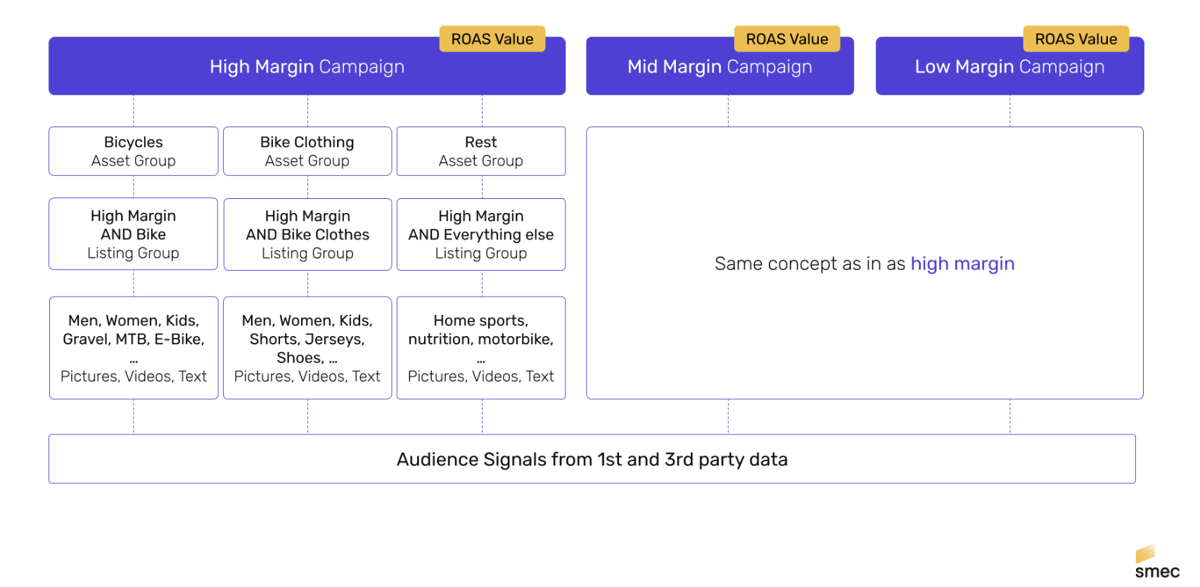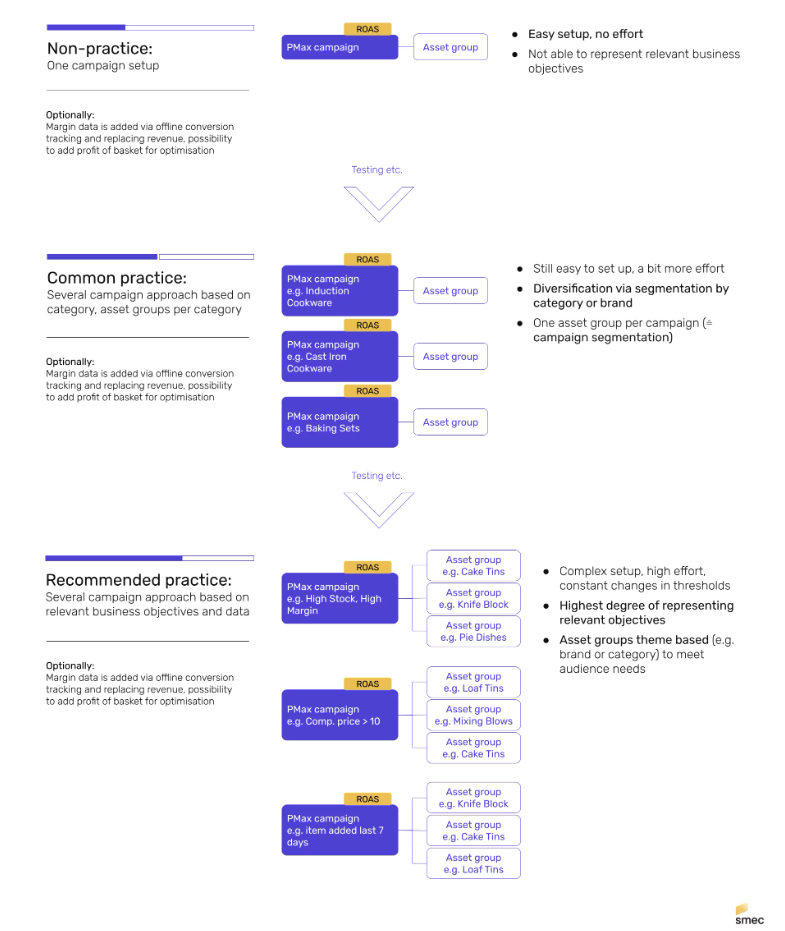Performance Max campaigns are a popular choice for eCommerce businesses, and there’s a reason why: they operate solely on automation and machine learning. And the fact they are conversion or conversion value focused makes them the ideal tool for selling products.
Using your objective, budget, and the assets, Google takes care of bid management and where to serve ads, harnessing all of Google's channels (Search, Display, YouTube, Discover, Maps, and Gmail).
If you’re new to PMax campaigns, give this guide to Performance Max campaigns a read, otherwise, let’s get stuck in.
Campaign Structure Is The First Step to PMax Success
On paper, Performance Max campaigns are epic from a management perspective, freeing up time that would have been spent on day-to-day management. However, that doesn’t mean there aren’t drawbacks to this campaign type.
Fellow advertisers have probably encountered inflated conversion data with the inclusion of branded searches, issues with a poorly optimized shopping feed, resource issues for the numerous assets needed, and the general lack of control and visibility over ad placement and reporting. But despite these things, they can drive excellent results.
Unfortunately, there isn’t a one-size-fits-all approach. But there are some important considerations to mull over that will ultimately shape how you structure your PMax campaigns.
The structure will play a big role in determining the success of your Performance Max campaigns, so it’s vital to build this into your strategy. It can mean the difference between setting up profitable campaigns or wasting budget on tests.
3 Performance Max Campaign Fundamentals To Follow
Let’s remind ourselves of some of the fundamentals needed for Performance Max campaigns to be successful, which will, in turn influence your campaign structure. When developing a strategy, I like to keep the following three fundamentals at the forefront of my mind, and you should too:
1. Daily budget for a Performance Max campaign
It’s recommended that daily spend is between $50 and $100 USD for a Performance Max campaign. Ask yourself if you have enough budget to run multiple campaigns, or perhaps you just have enough for one campaign. Or none at all if you’re working with a smaller account.
If you’re wondering why there’s a recommended minimum spend, it’s because data is what fuels these campaigns. In theory, a higher budget = a healthier amount of data.
As well as budget, it’s also a question of commitment…Google recommends that Performance Max campaigns run for at least 6 weeks to allow the machine learning algorithm to ramp up and have sufficient data.
2. How CPA should align with daily spend
So, we know there’s a recommended minimum daily spend for PMax campaigns, however, there is another fundamental layer to consider. It’s also recommended that the average daily budget is at least 3X your CPA.
Let’s do the math. If your target CPA is $50, then the recommended daily budget for your campaign would be at least $150. In an ideal world daily spend will be 10x the target CPA (or greater), however, in this scenario the recommended minimum daily spend would be $150.
Let’s crunch a few more numbers to give you an idea:
- $10 Target CPA, so the recommended minimum daily spend is $50 +
- $25 Target CPA, so the recommended minimum daily spend is $75 +
- $150 Target CPA, so the recommended minimum daily spend is $450 +
- $500 Target CPA, so the recommended minimum daily spend is $1.5k +
3. Conversion data
I’ve said it once and I’ll say it again, because it’s important - data is the fuel that powers PMax campaigns. This includes your conversion data so it needs to be top-notch.
Performance Max campaigns either use conversion, or conversion value based bidding, and your entire campaign will be based off of your conversion data. Here are a couple of ways this influences your campaign:
- Google will target people and optimize your campaign for people who are most likely to perform your chosen conversion goal. So make sure it’s valuable to you, such as a purchase, and include as much data as possible, such as revenue (or conversion value)
- You can use audiences at campaign level to help give your campaign more insight into who your ideal customer is. Google will use these audience ‘signals’ to help give your campaign an extra steer
- The recommended number of conversions or purchases in a given month is at least 30. Less than 30 could mean not enough data for a campaign to be optimal. The more the merrier.
In short, conversion data needs to be accurate, high quality, and bountiful. Remember these 3 Performance Max fundamentals and keep repeating them as we delve a little deeper into the ideal Performance Max campaign structure for eCommerce.
Expert tip: use the Google Ads Tag to track your conversions, instead of or alongside importing goals from Google Analytics. This will enrich your conversion data and provide more accurate attribution.
Will One Performance Max Campaign Be Enough?
Probably not. A one-campaign approach is not the recommended way to go. This is because you’ll have zero control over what products are shown and when, since everything will be grouped together. Yes, a simple approach is recommended, but if it’s too simple you’ll miss a trick. Instead, let’s look at some logical ways to break campaigns into ‘buckets’.
An Exception to Breaking Campaigns Into Buckets
If setting up multiple campaigns means you will fail to adhere to the 3 fundamentals mentioned above, then I would advise sticking to one campaign. For example, if you only have only $50 per day to spend, or you will only generate 25 to 30 conversions in a month.
If this is you, be smart about running just the one campaign by prioritizing an area of the business or selection of products - or bucket - rather than throwing everything into that one campaign. Read on and then work out what you could prioritize.
Upgraded Smart Shopping Campaigns
Smart Shopping campaigns would have been automatically upgraded to Performance Max campaigns in 2022, unless you manually upgraded them before. With a sigh of relief, existing campaign settings will have remained the same. However the upgraded campaign will now be eligible for all of the new features that come with PMax, from ad inventory, audience signals and insights, etc.
Factor this legacy Smart Shopping campaign into your structure, which we will delve into in the next section. Repurpose the campaign by walking through all of the campaign settings and ensure it’s optimised.
5 Ways To Structure Your Performance Max Campaigns
Splitting campaigns into buckets is the best approach, and this should be done based on what makes sense for your individual business. These buckets should also be condensed as much as possible since this exercise isn’t to implement a granular structure.
Performance Max campaigns are supposed to be broad. We want them to be broad so that automation and machine learning can work its magic. However, providing some focus will help with performance and profitability.
1. Profit margin and product performance
Generating profit is probably the number one objective of any eCommerce business. Group products in your data feed into buckets based on how profitable they are and how they perform.
Let’s say you have thousands of products and only half of them are profitable on Google Ads. The profitable half could be grouped into a bucket. This could be further broken down by profit margin. For example, you could have one bucket with high-margin products and one with low-margin products. Or take this one step further by having multiple buckets based on profit margin percentage, rather than just high and low.
This would be a pretty solid way to structure your campaigns since budget, target CPA and target ROAS is set at a campaign level. So if you set up a high-margin and a low-margin campaign, you could prioritize the high-margin campaign with more budget and customize your CPA / ROAS targets for each, given the difference in performance.
For a deeper practical insight on this, check out our most recent PMax Case Study.
2. Stock and business objectives
Similarly to the above, you might want to group products based on stock levels. There’s no point in advertising products that are out of stock for obvious reasons. The business might want to focus on products that are high in stock, or there might be a particular product or a group of products that the business wants to give more visibility to.

Some scenarios I’ve encountered are poor-performing products that are high in stock and the business wants to shift. Or seasonal products and objectives, such as spring / summer versus fall / winter collections. Buckets based on a particular holiday or event, such as Easter, Mother’s Day, Halloween, Diwali, Christmas, Veganuary, etc, might be appropriate for you.
Since Performance Max campaigns are designed to prioritise the top performing products, you might consider running a Standard Shopping campaign alongside your Performance Max Campaigns as well. This is to give your low performing products visibility in the Standard Shopping campaign, whilst you gather data and insight into their performance.
These scenarios could be a way of grouping products into buckets that would benefit the structure of your Performance Max campaigns. Consider stock and business objectives and pair that with product performance and profit margin, so your buckets are formed from multiple layers, not just one factor.
Prioritizing new customers
If your business objective is new customer acquisition, consider using the feature ‘Bid higher for new customers than for existing customers’. This would be ideal for advertisers who are adopting a full funnel strategy and looking to drive growth. The campaign would then bid more competitively for new customers, shifting the campaign’s focus. If customer retention is equally as important as new customer acquisition (or more important) then it may not be right for you.
Google Performance Max Campaign Settings
3. Don’t Forget Product Themes
Performance Max is intended to be thematically driven, with the assets in a campaign dynamically used to advertise a particular theme. However, the attributes mentioned above - profit margin, performance, stock, and objectives - don’t consider product themes. Products within buckets based on profit margin, or seasonal performance, may be completely different from one another.
For example, an eCommerce business might focus on selling knitted jumpers and Christmas tree decorations in Q4. Even though both items deliver the same profit margin and are seasonal, they have very little in common thematically. Should they be included in the same bucket? Perhaps not. The solution here is you must consider both business attributes and product themes.
The following diagram is great for illustrating how to do this.

Source: Smarter-ecommerce.com
It shows how products can be further broken down into buckets, and in this example, there are 3 campaigns; high, mid, and low-profit margin. Products have then been grouped together in buckets using asset groups and listing groups, something we will explore later. Alternatively, you could have a campaign for each product type if that’s going to make the most sense for you.
When forming your campaign structure, I recommend you map it out in a similar way before building. Remember, this needs to be tailored to your individual business needs. Also, keep in mind the fundamentals we ran through earlier on in this article.
Tip:
If you’re using a data feed, a good way to categorize your product data is by using the product_type attribute. You can then use these categories or groupings to structure your asset groups. An example of a product_type string is Kitchen & Dining > Kitchen Appliances > Toasters. To create this kind of classification easily based on your existing product data, you can use data feed management software like DataFeedWatch.
4. Make Sure Campaigns Have Enough Conversion Volume
Finally, as previously mentioned, it’s really important that campaigns generate enough conversions. Specifically, the recommended number is 30 conversions in a month. When breaking campaigns into buckets, ask yourself if the buckets will generate enough conversions to be successful.
This might be trickier for retailers selling high-value products in lower volumes. Compared to lower-value products that are sold in higher volumes. For the latter, it’ll be easier to split your campaigns into buckets. Whereas the former businesses may not be able to because it might spread conversion data too thinly.
For any business, go that extra mile when setting up conversion tracking by tracking the full funnel. This will provide Google with more data and a fuller picture of customer behavior right before purchasing. If that means spending additional time and resources on event tracking, and tools such as offline conversion tracking and CRM integration, then it’s worth it.
5. Use Asset Groups when Structuring Campaigns
Use asset groups within your Performance Max campaign to group products together that are similar and build this into your structure. You have 100 asset groups per campaign to play with, which should be more than enough.
Source: Google Ads blog
Asset groups should be tightly themed to the products within the group, so that images, videos, headlines, descriptions, and inventory relate to the theme or group of products. Remember, asset groups, are essentially ad groups.
Listing Groups, which are part of a campaign’s asset group, can be used to organize your listings by the attributes assigned to them in the Merchant Center. Use them to manage which listings are included in your campaigns.
Maybe feed-only campaigns?
Until recently, for those eCommerce businesses that wanted to focus on Shopping (perhaps you had success with Smart Shopping in the past), it was also possible. All you had to do was use your data feed in a Performance Max campaign, but not upload any assets to the asset groups and then your campaign was only be eligible to run on Shopping, Display, and YouTube, in a product placement format.
Right now it's not so certain.
In early August 2023, Google has introduced a major update that could bring significant changes for advertisers who rely on feed-only campaigns for Performance Max. Although the announcement was made quietly, it is important to understand the implications.
Previously, if you chose to run a feed-only campaign without any resources, Performance Max automatically dedicated your entire budget exclusively to the Shopping network. However, with the latest update, the situation has changed. Google now has the ability to use product images from the feed and, based on those images, display auto-generated ads on popular platforms such as YouTube and perhaps even the Display Ad Network
We will see how this will play out in the future for advertisers running feed-only campaigns, but usually auto-generated ads are not of the highest quality and do not positively affect ad performance, so many advertisers would probably like to avoid this situation.
You can read all about creating Feed-only PMax Campaigns and the recent updates here.
Branded Searches in Performance Max Campaigns
Semi-related to structure, consider managing branded searches when running Performance Max. By default, PMax campaigns will include branded searches within your campaign unless you exclude them. I always keep brand and generic searches separate for a number of reasons, and the chances are you do too.
Contact your Google Rep and ask them to apply your chosen branded keywords as negatives to your Performance Max campaign, along with any other keywords you would like added as negatives. It’s rumored that this will soon be something advertisers can do themselves, but currently, you’ll need to use a Google Rep.
For more, check out our article on How to Add Negative Keywords to Performance Max Campaigns.
Read also about collections in Performance Max.
In a nutshell…
To conclude, the perfect Performance Max campaign structure for eCommerce, there’s no one answer, but there are two key things to remember. Firstly, it’s the fundamentals we discussed at the start of the article. They should be at the forefront of your strategy. Then consider how best to break your campaigns into buckets using criteria that best fits your business. Finally, let those buckets form your structure. Keep it simple, but also keep it smart. You get out what you put in.
Let’s end things with a crystal-clear diagram by Mike Ryan from Smarter Ecommerce. It offers three structural scenarios from the least recommended to what’s common practice, and then the most recommended approach. As you might expect, they also go from easy to complex in terms of setup, but with the most recommended practice likely being the most successful.

